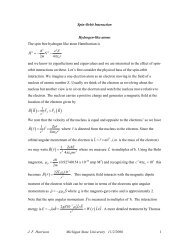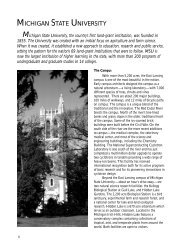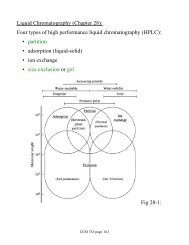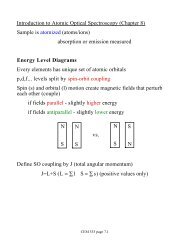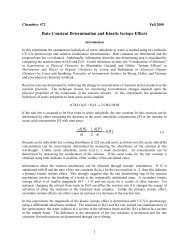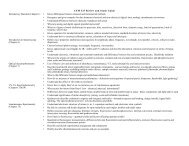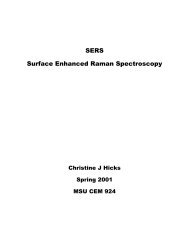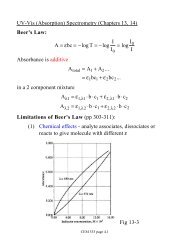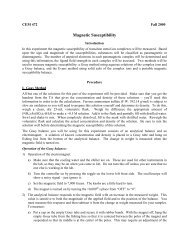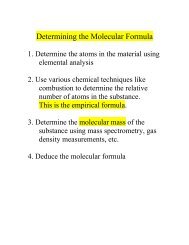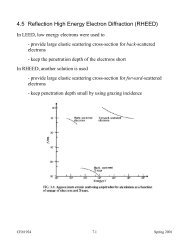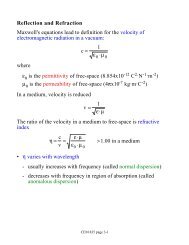chapter 5 - Department of Chemistry
chapter 5 - Department of Chemistry
chapter 5 - Department of Chemistry
Create successful ePaper yourself
Turn your PDF publications into a flip-book with our unique Google optimized e-Paper software.
Previous general trends held as, approaching the new millennium,the “central science” led the transformation fromthe Age <strong>of</strong> the Atom to the Biotechnology Century. Whilemaintaining its role from previous decades, analytical instrumentationdramatically shifted emphasis from petrochemicalsto biologicals, from geophysics to genomics. Technologicaldemands from industries and research fields notpreviously associated with traditional chemical instrumentationled to additional innovations in simplification, standardization,computerization, and “small footprint” benchtopequipment that could be used by a changing and diversely educatedworkforce that serviced the economically affluentbaby-boom generation seemingly benton both “living forever” and having it all.Military technology continued to followits pattern <strong>of</strong> demanding high-techinstrumentation as superconductors,fiber-optics, computers, satellite sensing,and laser technology led the way.Regulatory analysis expanded in complexitybeyond individual pollutants toissues <strong>of</strong> global warming; biological andchemical warfare; and the subtleties <strong>of</strong>endocrine disruption, bioremediation,and the genetic damage <strong>of</strong> large-scalepopulations, including the former Sovietstates. The possibilities <strong>of</strong> nanotechnology,biological computers, robotics, andartificial intelligence became plausiblesources <strong>of</strong> innovation in instrumentationrather than fantasy.On the international front, the emergence<strong>of</strong> the European Union providedadded impetus for a business-friendlygovernment in the United States to lookfavorably on corporate mergers and international marketing,all <strong>of</strong> which affected the analytical instrumentationbusiness and the larger chemical industry dramatically.The vast majority <strong>of</strong> innovations in instrumentationwere not in new kinds <strong>of</strong> analysis (as in previous decades,when major new forms <strong>of</strong> chromatography or spectroscopycame to light) but rather in the area <strong>of</strong> enhancements andcombinations <strong>of</strong> instruments. The wealth <strong>of</strong> possibilities forinterfacing and combining analytical techniques seemedIt will be an era inwhich the boundariesbetween basic andapplied science erode.Commercial relevancewill be an intrinsicfeature if not a statedgoal <strong>of</strong> most science.— Frank Press, president <strong>of</strong>the National Academy <strong>of</strong>Sciences, 1992destined for the long-term goal <strong>of</strong> creating a multidimensionalanalytical technology using all the various methods<strong>of</strong> analysis. This was the promise <strong>of</strong> the creation <strong>of</strong> a virtualStar Trek “tricorder,” which would analyze all things for allpeople just by pointing at an object. Such a developmentwas the prediction <strong>of</strong> Tony White, Perkin-Elmer CEO, atPittcon ‘96.The Corporate LandscapeVery early on, the promise <strong>of</strong> the past decade was suddenlypulled up short, according to Lawrence Schmid, president <strong>of</strong>SDI, Inc. “A general instrument industry slowdown has beenunder way in the United States for thepast year,” he said. The reasons for thisvaried, but lowered government fundingand the sudden fear that biotechnologywould not live up to its promise were two<strong>of</strong> the most important reasons given [Today’sChemist 1990, 3(1)]. The low level<strong>of</strong> growth in gross national product (GNP)was the final straw. Referring to Pittcons‘90 and ‘91, Schmid projected that “theinstrument industry appears to be takinga conservative view <strong>of</strong> the future whichdoes not include accelerated product developmentprograms.” Referring toPittcon ‘93, Ward Worthy wrote, “Therewas a sort <strong>of</strong> consensus . . . that the glorydays <strong>of</strong> the 1980s, when annual double-digitgrowth rates were the norm,were gone.” The analytical instrumentindustry was relatively flat [TCAW 1993,2(4)].“The trends in the late 1980s continuedthrough 1990; mergers and acquisitionsincreased in size and frequency.” [Today’s Chemist1991, 4(2)]. Later in the decade, Spectronics left Milton Roywhen purchased by Life Sciences International (LSI) in1995; Teckmar and Dohrman merged in 1995. AnalyticalTechnology Inc. (ATI) took over Orion, Mattson, Unicam,Russell, and Cahn. Both ATI and LSI were eventually sold toThermo Instruments Systems.The Thermo line <strong>of</strong> companies, all subsidiaries <strong>of</strong> ThermoElectron (founded in 1956), were by far the most amazing ex-84 Made to Measure March 1999 http://pubs.acs.org



